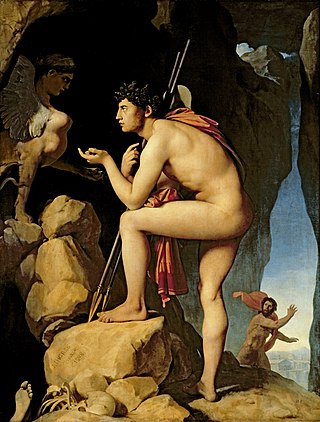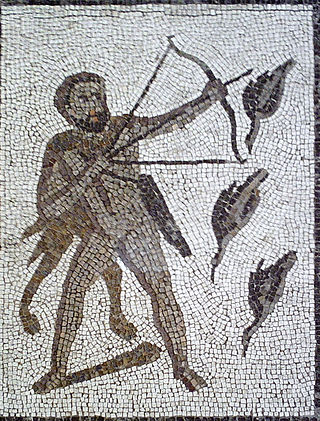Related Research Articles

In ancient Greek religion and Greek mythology, Pasiphaë was a queen of Crete, and was often referred to as goddess of witchcraft and sorcery. The daughter of Helios and the Oceanid nymph Perse, Pasiphaë is notable as the mother of the Minotaur. She conceived the Minotaur after mating with the Cretan Bull while hidden within a hollow cow that the Athenian inventor Daedalus built for her, after Poseidon cursed her to fall in love with the bull, due to her husband, Minos, failing to sacrifice the bull to Poseidon as he had promised.

Theseus was the mythical king and founder-hero of Athens. The myths surrounding Theseus – his journeys, exploits, and friends – have provided material for fiction throughout the ages.

Oedipus was a mythical Greek king of Thebes. A tragic hero in Greek mythology, Oedipus accidentally fulfilled a prophecy that he would end up killing his father and marrying his mother, thereby bringing disaster to his city and family.

In Classical Greek mythology, Hippolyta, or Hippolyte was a daughter of Ares and Otrera, queen of the Amazons, and a sister of Antiope and Melanippe. She wore her father Ares' zoster, the Greek word found in the Iliad and elsewhere meaning "war belt." Some traditional English translations have preferred the more feminine-sounding "girdle." Hippolyta figures prominently in the myths of both Heracles and Theseus. The myths about her are varied enough that they may therefore be about several different women.

The Nemean lion was a monster in Greek mythology that lived at Nemea. Eventually, it was killed by Heracles (Hercules). Because its golden fur was impervious to attack, it could not be killed with mortals' weapons. Its claws were sharper than mortals' swords and could destroy any strong armour. In Bibliotheca, Photius wrote that the dragon Ladon, who guarded the golden apples, was his brother.

The Lernaean Hydra or Hydra of Lerna, more often known simply as the Hydra, is a serpentine water monster in Greek and Roman mythology. Its lair was the lake of Lerna in the Argolid, which was also the site of the myth of the Danaïdes. Lerna was reputed to be an entrance to the Underworld, and archaeology has established it as a sacred site older than Mycenaean Argos. In the canonical Hydra myth, the monster is killed by Heracles (Hercules) as the second of his Twelve Labors.

The Mares of Diomedes, also called the Mares of Thrace, were a herd of man-eating horses in Greek mythology. Magnificent, wild, and uncontrollable, they belonged to Diomedes of Thrace, king of Thrace, son of Ares and Cyrene who lived on the shores of the Black Sea. Bucephalus, Alexander the Great's horse, was said to be descended from these mares.

Mythology of the Iroquois includes the creation stories and folktales of the Native Americans who formed the confederacy of the Five Nations, later the Six Nations. Historically, these stories were recorded in wampum and recited, only being written down later. In the written versions, the spellings of names differ due to transliteration and spelling variations in European languages that were not yet standardized. Variants of the stories exist, reflecting different localities and times.
Seneca mythology refers to the mythology of the Seneca people, one of the six nations of the Iroquois Confederacy from the northeastern United States.

Sweden Township is a township in Potter County, Pennsylvania, United States. The population was 871 at the 2020 census.

Among the Haudenosaunee the Great Law of Peace, also known as Gayanashagowa, is the oral constitution of the Iroquois Confederacy. The law was written on wampum belts, conceived by Dekanawidah, known as the Great Peacemaker, and his spokesman Hiawatha. The original five member nations ratified this constitution near modern-day Victor, New York, with the sixth nation being added in 1722.

Waterloo is a town in Seneca County, New York, United States. The population was 7,338 at the 2020 census. The town and its major community are named after Waterloo, Belgium, where Napoleon was defeated.
The Seneca are a group of Indigenous Iroquoian-speaking people who historically lived south of Lake Ontario, one of the five Great Lakes in North America. Their nation was the farthest to the west within the Six Nations or Iroquois League (Haudenosaunee) in New York before the American Revolution.

Cleitus the Black, was an officer of the Macedonian army led by Alexander the Great. He saved Alexander's life at the Battle of the Granicus in 334 BC and was killed by him in a drunken quarrel six years later. Cleitus was the son of Dropidas and brother of Alexander's nurse, Lanike. He would be given the epithet 'the Black' to distinguish him from Cleitus the White.

Ganondagan State Historic Site, also known as Boughton Hill, is a Native American historic site in Ontario County, New York in the United States. Location of the largest Seneca village of the 17th century, the site is in the present-day Town of Victor, southwest of the Village of Victor. The village was also referred to in various spellings as Gannagaro, Canagora, Gandagora, Gandagaro and Gannontaa.

Phaedra is a Roman tragedy written by philosopher and dramatist Lucius Annaeus Seneca before 54 A.D. Its 1,280 lines of verse tell the story of Phaedra, wife of King Theseus of Athens and her consuming lust for her stepson Hippolytus. Based on Greek mythology and the tragedy Hippolytus by Euripides, Seneca's Phaedra is one of several artistic explorations of this tragic story. Seneca portrays Phaedra as self-aware and direct in the pursuit of her stepson, while in other treatments of the myth, she is more of a passive victim of fate. This Phaedra takes on the scheming nature and the cynicism often assigned to the nurse character.
Gaasyendietha, according to Seneca mythology, is a giant serpent that dwells in the deep areas of rivers and lakes of Canada, especially Lake Ontario. This serpent could fly on a trail of fire, and it could also spew fire, which has led to it being viewed as analogous to European dragons.

Amelia Jenks Bloomer was an American newspaper editor, women's rights and temperance advocate. Even though she did not create the women's clothing reform style known as bloomers, her name became associated with it because of her early and strong advocacy. In her work with The Lily, she became the first woman to own, operate and edit a newspaper for women.

The Stymphalian birds are a group of voracious birds in Greek mythology. The birds' appellation is derived from their dwelling in a swamp in Stymphalia.
Canoga is a hamlet in the Town of Fayette, Seneca County, New York, United States, along Cayuga Lake. It is located seven miles southeast of the hamlet of Seneca Falls, at an elevation of 449 feet. The primary cross roads where the hamlet is located are N.Y. Route 89 and Canoga Road.
References
- ↑ Bane, Theresa (2016). Encyclopedia of Beasts and Monsters in Myth, Legend and Folklore. McFarland. p. 103. ISBN 978-1-4766-2268-2 . Retrieved Aug 18, 2018.
- ↑ Curtin, Jeremiah; Hewitt, J.N.B. (1918). "Seneca Fiction, Legengs, and Myths". Thirty-Second Annual Report of the Bureau of American Ethnology: 376. Retrieved Aug 18, 2018.